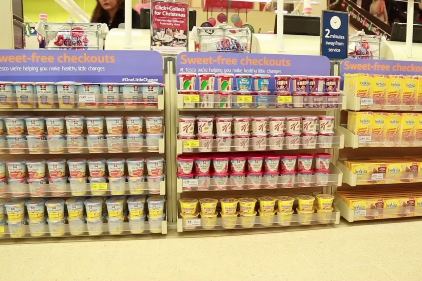
|
| Tesco, a UK supermaket chain, is no longer offering candy at its checkouts. Photo provided by Tesco. |
This is the kind of news that makes everyone in the candy industry say, “Son of a gum!”
Tesco, the largest supermarket chain in the U.K., has decided to remove confectionery from all of its front ends. Admittedly, it’s not a total shocker — the chain already removed the candy from the checkout lanes at its larger stores. Now though, it’s planning to do the same thing at its smaller locations, including Tesco Metro and Express convenience stores.

|
| Crystal Lindell |
The company says it’s replacing the sweets and chocolates with healthier choices, claiming it will help parents fend off requests from children for the treats, which it calls “pester power.”
“As the U.K.’s largest food retailer, we have a responsibility to make it easier for our customers to lead healthier lifestyles,” says David Wood, managing director of health and wellness, Tesco.
And Tesco isn’t the only retailer taking candy away from the front end. Lidl, another UK grocer, did the same thing last year.
This is not good news.
I can remember being at the Sweets and Snacks Expo a couple years ago, having a conversation with a Mars executive about self-checkouts. He said they dramatically decreased the amount of candy people bought because they usually reduced the amount of time people spent in line. “This is what keeps me up at night,” he told me.
Well, if self-checkouts are keeping him up at night, this must be giving him a heart attack.
I don’t blame him.
I mean, bam, with one quick swipe, Tesco is basically obliterating the candy aisle.
Yeah, yeah, I know, technically, the candy aisle, is well, in the actual candy aisle, but who the heck ever goes there? Look, the confectionery industry itself even admits that the candy aisle is kind of boring.
“A majority of shoppers find the candy category the hardest to shop and the least inspiring in the store, resulting in many shoppers walking away without any confection in their basket,” says Rick Price, senior manager of center store evolution at Hershey.
For its part though, Hershey made that statement while simultaneously releasing a totally re-imagined candy aisle display.
The chocolate maker designed a test “store within a store” for the candy section at Winn-Dixie’s Baton Rouge, La., location, with bold displays staged in a circular formation to replace the traditional candy aisle.
The new “Candy Experience” section displays Hershey’s own products as well as those from competitors. The stands are topped with enticing icons such as a large Reese’s Peanut Butter Cup, a Hershey’s Kiss or a M&M. And, the section also features colorful graphics and convenient organization by usage occasion.
Moreover, if other stores follow Tesco’s example, it might be the confectionery industry’s best shot at grabbing shoppers’ attention.
Regardless of how this whole thing affects confectionery makers though, the bottom line is taking candy away from the front end in an effort to encourage healthier eating just doesn’t make much sense...no matter how you look at it.
For retailers looking to make a profit, “the gross-margin for candy at the front end does indeed tend to be higher than that in-aisle,” says the National Confectioners Association.
But let’s say, somehow, you’re a retailer with enough money, and you don’t care about silly things like profits. Well, there’s still plenty of reasons to leave candy at register.
The fact is, “the majority of shoppers like having the option to buy candy at checkout,” says the NCA. “Consumers see checkout candy as an infrequent treat.”
Specifically, about 56 percent of shoppers buy checkout candy as a treat or reward for themselves, while only 4 percent buy it as a meal replacement. Furthermore, consumers tend to average less than two grocery trips a week, only buy candy at the checkout sometimes (37 percent) or hardly ever (45 percent), while only 2 percent do so “almost every time” versus 16 percent who never do.
The National Confectioners Association also sites USDA data showing that candy is actually only about 2 percent to 3 percent of the average American’s diet, and only 3 percent of the average child’s diet.
And, a National Health and Nutrition Examination Survey shows that less than 5 percent of total sugars in the diet are from candy. Less than 5 percent! That stat alone should be enough to persuade people to leave candy alone.
Alas, it is not. Luckily, there’s still a way for everyone to win.
“Some retailers have chosen to offer a greater mix of items at the front end, to include things like batteries, trail mix, baked goods, or even fruit,” says Jenn Ellek, senior director, trade marketing and communications for the NCA. “Others, have implemented one or two lanes that do not feature things like soda and candy as to provide choice for the shopper. In the end, that's what this debate should be all about. Shopper choice.”
Look, as a human being, I completely understand the impulse retailers might have to eliminate candy from the front end in hopes of curbing obesity. It’s easy to pick the thing that looks most like what the perceived problem is and attack it. And candy does have a lot of sugar in it. The problem is, most of our diets don’t actually have a lot of candy in it.
So, the fact remains, that, unfortunately, obesity is not and never will be anything like smoking or drinking. There is never going to be a way to outright ban the cause of it, and nobody, not even those most committed, will ever be able to quit food cold turkey — not even Tesco.

